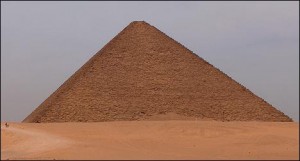The Red Pyramid at Dashur has the second largest base of any pyramid in Egypt, only slightly smaller then the Great Pyramid of Khufu at Giza; each side measures 220m. However, with it’s sides sloping at 43?22′, it is substantially shorter at 104 meters. Nevertheless, it is the fourth highest pyramid ever built in Egypt, with almost 160 layers of stone.
 Stripped from its limestone casing, this pyramid reveals the reddish sandstone used to build most of its core. This explains its modern-day name, the Red Pyramid. Its Ancient Egyptian name was “The Shining One”. The severe structural problems encountered while building the Bent Pyramid South of Dashur, led Snofru (Sneferu) to build yet another pyramid, at a small distance to the North. Significantly, the Red Pyramid was the first successful, true, cased Pyramid built in Egypt, ushering in the era of the Giza style pyramids. Built by Khufu’s father, Snefru, what really makes this pyramid special today is the lack of crowds and circus atmosphere that plagues the Giza Plateau, along with the fact that it can currently be entered without limitation. Tura limestone was used as casing stone to cover the pyramid. Though some casing still remains, most has been removed. However, about every twentieth casing stone discovered had inscriptions on the back sides. Some were inscribed with the cartouche of Snefru while others had inscriptions in red paint naming the various work crews, such as the “Green Gang” or the “Western Gang”. Snefru’s cartouche was an important discovery, particularly since there are no identifying inscriptions within the pyramid.
Stripped from its limestone casing, this pyramid reveals the reddish sandstone used to build most of its core. This explains its modern-day name, the Red Pyramid. Its Ancient Egyptian name was “The Shining One”. The severe structural problems encountered while building the Bent Pyramid South of Dashur, led Snofru (Sneferu) to build yet another pyramid, at a small distance to the North. Significantly, the Red Pyramid was the first successful, true, cased Pyramid built in Egypt, ushering in the era of the Giza style pyramids. Built by Khufu’s father, Snefru, what really makes this pyramid special today is the lack of crowds and circus atmosphere that plagues the Giza Plateau, along with the fact that it can currently be entered without limitation. Tura limestone was used as casing stone to cover the pyramid. Though some casing still remains, most has been removed. However, about every twentieth casing stone discovered had inscriptions on the back sides. Some were inscribed with the cartouche of Snefru while others had inscriptions in red paint naming the various work crews, such as the “Green Gang” or the “Western Gang”. Snefru’s cartouche was an important discovery, particularly since there are no identifying inscriptions within the pyramid.
East of the pyramid is what remains of a mortuary temple, as well as the first capstone (Pyramidion) ever found belonging to an Old Kingdom Pyramid. It was recovered in fragments and reconstructed. The mortuary temple itself, though nothing much remains, is significant because Snefru pioneered the east west alignment of Egyptian temples to match the path of the sun.